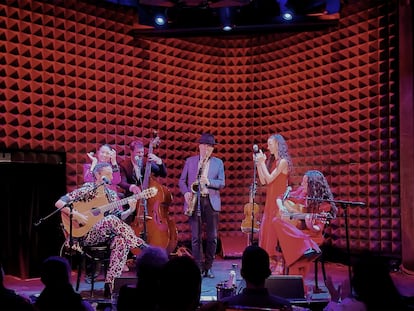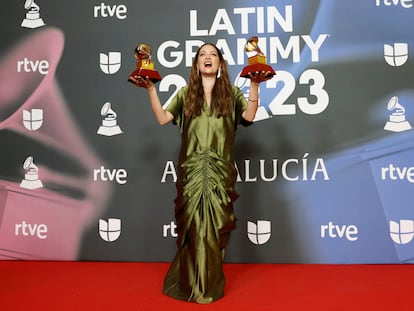Triana Ramos, Rosalía’s choreographer who dreams of performing at the Super Bowl
She fell in love with flamenco as a child and moved to Seville to learn the ropes. Now in her mid-twenties, she is one of the most sought-after dancers on the scene
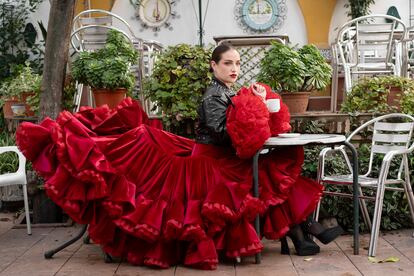
The movement of her hands cuts the air. The almost tomb-like silence is interrupted by the constant flash of the camera. Triana Ramos performs an improvised choreography in a flamenco tablao (a small performing stage) in the La Macarena neighborhood of Seville, in southern Spain, for the photographs that illustrate this story. She is late for the appointment, but she has an excuse. She spent the morning running around town looking for flamenco dresses and bridal veils for the photo session. “I wanted something that wasn’t too classic, that represented me better,” she says. It’s noon and she’s been awake since 5:30 a.m. to get everything ready. In recent years Ramos has worked as the choreographer for the video clip Amor amé by David Bisbal, for the Motomami World Tour by Rosalía, and for the beer company Cruzcampo’s latest ad campaign. She has also danced at the final of the 2022 UEFA Europa League, in addition to having performed on the most reputable flamenco tablaos in Spain.
After a long photo session, Ramos confesses that she doesn’t remember the first flamenco song she ever heard, but she does have a flashback of the first time she was in front of a tablao. “It was in Málaga, at the tablao where my mother [the dancer Carmen Sánchez] worked before she had me.” She was barely a few years old, but it was then that the passion for flamenco invaded her.

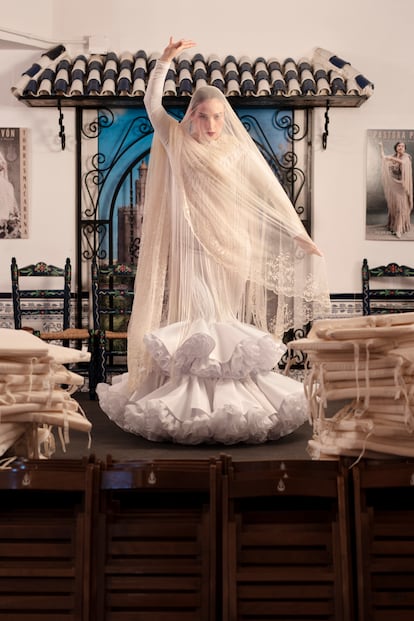
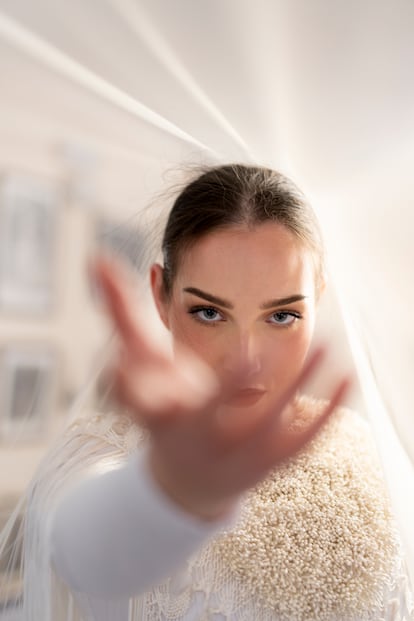
After growing up in Talavera de la Reina in Toledo province, where she was born in 1997, at the age of 18 she decided that she wanted to make a living from dance. Her mother warned her about the problems she would find in this world. The egos, the strong personalities of the artists, the difficulty making ends meet… “Even so, I wanted to take the risk,” she says. She left her home, her parents and her friends and headed south to start a new life in Seville, the cradle of flamenco, to begin her training as a dancer.
Only two years had passed since her arrival in the city when she heard about an audition that would kickstart her career. Seville was going to host the 2019 MTV EMA music award gala in November, and Ramos auditioned to be a dancer at the event. She was accepted, but did not know what artist she would be dancing with on stage. “In the first week of rehearsals I discovered that it was Rosalía,” she says. “I told her about it later and we both laughed.”
During the selection process, her father Joaquín Ramos, who had devoted his life to bullfighting, suffered a heart attack that he recovered from. In an hour-long interview, Ramos mentions his name up to eight times, admiration evident in her eyes. Her voice denotes nostalgia instead. “My parents’ family is from Salamanca, and my mother was going to be all alone with my father in Toledo. They weren’t going to get any help,” she recalls. It was in the hospital where he was recovering that her father told Triana to go live her dream. She kept her promise: she returned to Seville and performed at the MTV EMA gala.
A month after that event, she received a WhatsApp message saying that Rosalía wanted her to be her choreographer. Ramos, four years later, imitates the gesture she made then: she picks up the phone, looks at the screen, and locks it again. “I thought it was a joke in very bad taste. But my mother convinced me to find out more and I responded a few days later,” she recalls. It was no joke. Ramos began preparing the singer’s performance — dancing a seguiriya — at the 2020 Grammy Awards gala, which was held in Los Angeles. It was there that Rosalía established herself as the first artist from Spain to win the award for Best Latin Rock, Urban or Alternative Album for El mal querer.
In July of that year, seven months after her time in the United States, Joaquín Ramos died. “That was the real turning point in my life. His death has taught me in the worst way possible to see life from another perspective,” she reflects. When she remembers it, a special moment is created. Ramos shows herself the way she is. An empowered choreographer and dancer, and a twenty-something who lost her father too soon.
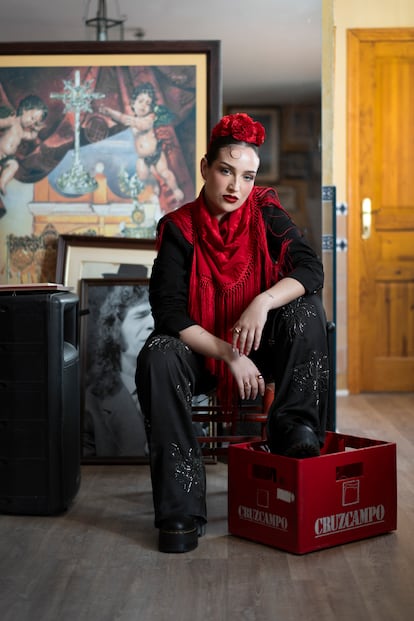

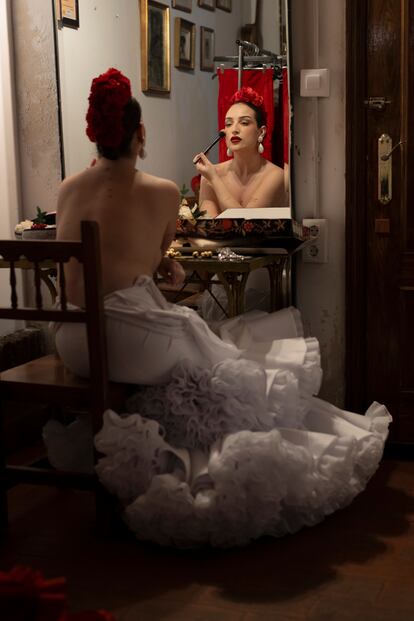
After that emotional blow, she took refuge in family and work. She says that flamenco was her lifesaver. In her dances, she explains, she tries to reflect who she is, to show her truth. “Flamenco captures you because it has the ability to connect with you and draw emotions from you, even if as a spectator you don’t know anything about the style.” And that, she says, is her goal with each dance: to be able to create an emotion in another person.
Months later, Ramos would be placed in charge of choreographing Rosalía’s Motomami World Tour. For that event she mixed flamenco with more urban dances, and created the now legendary Rosalía kick — which she recreates during the interview with innate ease. After touring stages and stadiums around the world with the Catalan singer, Ramos has now ventured into her latest work, a Cruzcampo advertising campaign called Gitana. In the video, to the sound of an unreleased bulería by the legendary singer Camarón de la Isla, she has designed a dance that revolves around the purest strains of the Andalusia region.
Triana is one of several young artists who champion the value of Andalusian roots and culture. “The beautiful thing about this land and its people is that they know how to stand up for where they come from. We must never lose that essence,” she says. Andalusia has become her own home.
At the end of the interview, she confesses that her dream is to become a dancer or choreographer at the Super Bowl. “It’s complicated, but not impossible. Why could’t I do it? I believe that with self-confidence, effort and a whole lot of work, I can get to wherever I want to go. I am the one who sets the limits for myself.”
Sign up for our weekly newsletter to get more English-language news coverage from EL PAÍS USA Edition
Tu suscripción se está usando en otro dispositivo
¿Quieres añadir otro usuario a tu suscripción?
Si continúas leyendo en este dispositivo, no se podrá leer en el otro.
FlechaTu suscripción se está usando en otro dispositivo y solo puedes acceder a EL PAÍS desde un dispositivo a la vez.
Si quieres compartir tu cuenta, cambia tu suscripción a la modalidad Premium, así podrás añadir otro usuario. Cada uno accederá con su propia cuenta de email, lo que os permitirá personalizar vuestra experiencia en EL PAÍS.
¿Tienes una suscripción de empresa? Accede aquí para contratar más cuentas.
En el caso de no saber quién está usando tu cuenta, te recomendamos cambiar tu contraseña aquí.
Si decides continuar compartiendo tu cuenta, este mensaje se mostrará en tu dispositivo y en el de la otra persona que está usando tu cuenta de forma indefinida, afectando a tu experiencia de lectura. Puedes consultar aquí los términos y condiciones de la suscripción digital.
More information
Archived In
Últimas noticias
Imelda Castro, the woman who wants to rule the cartel battleground of Sinaloa
The new victims of the Republican war on Obamacare: Millions hit by soaring health insurance premiums
A country divided on migrant rights: Some US states expand protections while others restrict them
Venezuela authorizes the release of another 87 political prisoners
Most viewed
- David King, chemist: ‘There are scientists studying how to cool the planet; nobody should stop these experiments from happening’
- Reinhard Genzel, Nobel laureate in physics: ‘One-minute videos will never give you the truth’
- Oona Chaplin: ‘I told James Cameron that I was living in a treehouse and starting a permaculture project with a friend’
- Sinaloa Cartel war is taking its toll on Los Chapitos
- The Interoceanic Train, the Mexican alternative to the Panama Canal

